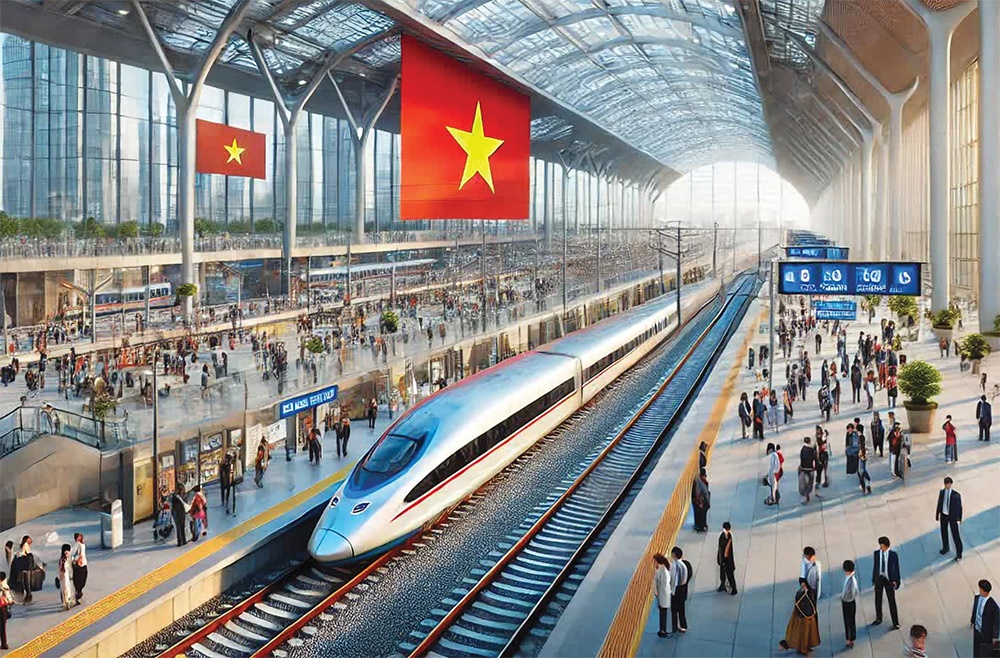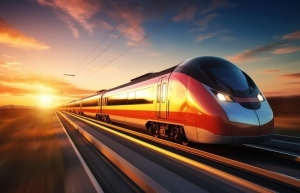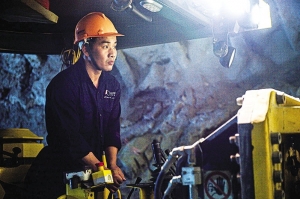Major railway requires debt considerations
The government submitted a proposal to the National Assembly (NA) last week, seeking approval for the North-South high-speed railway project. The estimated cost of this ambitious venture is $67.34 billion, with construction expected to begin in late 2027 and conclude by 2035.
 |
| Major railway requires debt considerations |
Spanning more than 1,540km, the railway will connect Ngoc Hoi station in Hanoi to Thu Thiem station in Ho Chi Minh City, passing through 20 provinces and cities. The system will be a double-track railway with electrified infrastructure, allowing for speeds of up to 350km per hour. While primarily designed for passenger transport, the railway will also meet dual-use requirements for national defence and security and be capable of transporting goods if required.
The project will utilise nearly over 10,800 hectares of land and adopt advanced technology equivalent to that used in developed countries with high-speed rail systems. It is anticipated to unlock significant economic opportunities by leveraging land resources, boosting the development of industries such as construction and materials, and supporting tourism, services, and urban development.
Additionally, the railway is expected to reduce environmental pollution, decrease traffic accidents, and create millions of jobs. During construction, the project is projected to contribute an average of 0.97 percentage points annually to GDP growth.
The National Assembly Economic Committee (NAEC) conducted extensive consultations with experts and relevant agencies to assess the feasibility of the project. In its report to the NA, the committee noted that the proposal aligns with Vietnam’s railway network development plan towards 2030.
However, while broadly supportive of the government’s proposal, the committee recommended further studies to ensure the railway integrates effectively with the national railway network, urban rail systems, expressways, and regional and international railway connections.
Despite its transformative potential, the project’s substantial capital requirements have raised concerns. The government estimates the project’s total cost at $67.34 billion, which will be fully state-funded. However, under the NAEC’s calculations, this figure exceeds the total mid-term public investment (MTIP) capital from the central budget for 2021-2025 by 114 per cent, and accounts for 60 per cent of the total MTIP capital volume from the state coffers in this period.
Capital allocation
NAEC Chairman Vu Hong Thanh emphasised the importance of a detailed analysis of the capital structure. He pointed out that the government’s proposal lacks specifics on funding requirements for each stage of the project.
“This is not in line with the regulations in the Law on Public Investment and will need to be carefully considered and discussed by the NA, so that special policies and mechanisms can be devised and applied to the project,” Thanh stated. “This will help ensure legal foundations for the project’s implementation process, especially ensure the compliance of the current law, and the Politburo’s Regulation No.189-QD/TW released in October 2024 on controlling power, and preventing and combating corruption in use and management of public finance and assets.”
When it comes to the capacity of the state budget for this project, the government’s proposal and other relevant documents submitted to the NA have also failed to specify investment periods, and estimated capital for each individual period. Meanwhile, this is a crucial job that needs discussions and coordination among relevant ministries and agencies to that a specific capital mobilisation scheme can be made, according to the NAEC.
What is more, the pre-feasibility study announced by the government also highlighted significant ongoing costs. From 2036 to 2066, the railway is projected to incur annual operation and maintenance expenses of VND25 trillion ($1 billion). However, the government has not clarified funding sources for these expenses.
“Therefore, in order to have a basis for the NA to consider and decide, the government is requested to report more clearly on the capital mobilisation and allocation plan, and the ability to balance the state budget capital used for the whole railway project,” the NAEC stated. “At the same time, it is proposed that the government review the portfolios of capital for priority investment projects in the coming stages and the priority capital allocation plan for the projects, and report to the NA for determination on each stage accordingly.”
The government proposes funding the project over the next 12 years, with annual disbursements of $5.6 billion. This represents about 1.3 per cent of GDP in 2023 and 1 per cent of GDP in 2027 when construction is expected to commence. The government asserts that the project will not compromise public debt safety, government debt, or foreign debt levels.
“By 2030, all three indexes will be lower than the permissible limits [of under 50 per cent of GDP]. Meanwhile, the national foreign debt repayment and budget deficit will likely increase,” the proposal said. “After 2030, the public debt will likely be lower than the permissible level, while other indexes may increase but not much as compared to the scenario of no investment in the high-speed railway.”
The government also underlined that this scenario of assessing the public debt safety index does not take into account the project’s contribution to GDP growth during the construction period. The investment cost for facilities and equipment will be repaid by Vietnam Railways Corporation, and there will be revenues from land exploitation in the project’s areas, and the project’s commercial operations.
However, the NAEC has argued that national foreign debt repayments and the budget deficit will likely increase at a high level.
NAEC calculations revealed that the budget overspending will average at 4.1 per cent of GDP, up by more than 30 per cent as compared to the targeted level of only 3 per cent, while the national foreign debt repayment will average at as much as 33-34 per cent of GDP, which will be far higher than the permissible limit of 25 per cent of total state budget revenues.
Ensuring legal compliance
Last week at the NA, many deputies said that like in the past, the state budget in the coming years will likely still face a deficit, with the source of public investment capital largely coming from loans. They emphasised the need for prudent budget management to ensure macroeconomic stability. Resolution No.07-NQ/TW on restructuring the state budget and managing public debt was cited as a framework for maintaining financial sustainability.
NA deputy Hoang Van Cuong representing Hanoi suggested that in the NA’s resolution on adopting the construction of the railway project, it is necessary to clarify the function of the project: transport passengers or goods. “Special attention must be paid to the investment form and the possible risks of investment capital addition,” Cuong said. “For example, a number of urban railway projects in Hanoi and Ho Chi Minh City have been delayed for many years, with investment capital increased.”
“Moreover, the important thing is technological transfer. We need to master all stages of investment and avoid any technological dependence during the project’s lifecycle,” Cuong continued. “It is not important to cooperate with any foreign nation in tech, but it is important that we must have it transferred. If we rely on foreign tech, it will be very costly during installation, repair, and maintenance which will lead to financial debts for the future.”
The NAEC recommended that the government assess the project’s potential impacts on public debt and budget deficits in the medium and long term. Strict adherence to public debt safety indicators is essential to ensure national financial security and avoid undue debt repayment pressures in future periods.
It also called for the government to clarify the capital mobilisation and allocation strategy to ensure the project’s alignment with national regulations. Specifically, the committee stressed the importance of adhering to the Law on Public Investment and rules which govern public finance and asset management to prevent corruption and ensure transparency.
Additionally, the government was urged to review and report on priority initiatives for upcoming stages and outline specific capital allocation plans. This includes providing detailed assessments of the impact on public debt, the budget deficit, and the state’s capacity to repay loans over the medium and long term. Deputies emphasised that ensuring sustainable public finance should remain a top priority.
By ensuring transparency, adhering to legal frameworks, and carefully managing resources, Vietnam’s leaders say the country can work towards completing this transformative project while maintaining financial stability and public trust.
 | High-speed rail could yet become reality To ensure that a high-speed north-south railway proposal maximises opportunities for socioeconomic breakthroughs, the planning, resource mobilisation, and implementation are undergoing rigorous consideration. |
 | Investment opportunities abound in railway infrastructure Efforts are underway to promote the railway sector for investment, as two new national railway lines are scheduled for investment sooner than planned, with more to follow. |
 | Metro Line 1 begins trial runs at full capacity The first metro line in Ho Chi Minh City, linking Ben Thanh Market in District 1 to Suoi Tien in Thu Duc, is conducting trial runs at full capacity from November 11 to 17. |
What the stars mean:
★ Poor ★ ★ Promising ★★★ Good ★★★★ Very good ★★★★★ Exceptional
Related Contents
Latest News
More News
- Vietnam's top 500 value-creating enterprises announced (December 27, 2025 | 08:00)
- The PAN Group shaping a better future with ESG strategy (December 26, 2025 | 09:00)
- Masan Consumer officially lists on HSX, marking the next phase of value creation (December 25, 2025 | 13:20)
- MCH to become the largest consumer stock on VN-Index (December 24, 2025 | 11:05)
- Oil and gas firms post strong 2025 results (December 22, 2025 | 17:42)
- SABECO wins multiple international beer awards (December 22, 2025 | 17:41)
- UOB sees Vietnam growth easing in fourth quarter (December 22, 2025 | 17:39)
- First members of Danang International Finance Centre revealed (December 22, 2025 | 17:39)
- Human-centred governance seen as key to AI development (December 19, 2025 | 18:19)
- Top 10 notable events of Vietnam’s industry and trade sector in 2025 (December 19, 2025 | 14:00)

 Tag:
Tag:






















 Mobile Version
Mobile Version